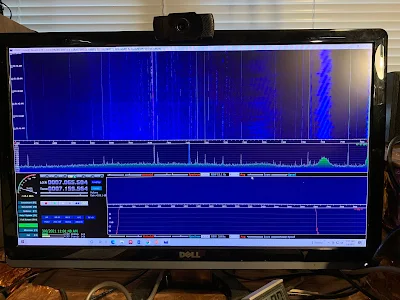http://soldersmoke.com/soldersmoke229.mp3
-- G2NJ Trophy is awarded to Pete Juliano, N6QW.
-- Get your vaccine shot as soon as you can!
-- More from "Conquering the Electron" by Derek Cheung.
-- Bad fire in the chip factory. Such a shame. Sad! I had NOTHING to do with it. I was home that day. I can prove it.
-- Bezos is not such a bad guy. Turns out he is a space-geek.
-- Perseverance was the big space news. Very cool.
Pete's bench:
Raspberry Pi vs.
Microcontrollers
Treedix display
Conversion of the Dentron Scout
CW rigs?
6L6 on a wooden chassis
SHAMELESS COMMERCE DIVISION-
I NEED TO BUILD UP TIME VIEWERS VIEW MY VIDEOS: So please watch!
https://www.youtube.com/channel/UC20TcdWSSFliMhg3k2A1a5w
-- Our Patreon sponsors get an early look at our YouTube content. So please, consider
becoming a Patreon sponsor.
-- Please continue to use the Amazon search engine on the blog page (upper right).
Bill's bench:
Hodgepodge:
-- BITX40
Module.
-- Ramseykit
Amp.
-- San Jian
counter,
-- CW using 750 Hz
oscillator.
-- RF-actuated piezo
buzzer.
-- SDR! SDR using PC and tablet.
-- Checking the output
with SDR.
-- Moving the carrier
osc frequency.
Also, I put the Fish Soup 10 back on the air. Nice contacts under 200 mw.
Up next: A rig for 80/75 and 20 meters. Single Conversion. Using VFO from a Yaesu FT101 that runs 8.7 – 9.2 Mhz. Quiz question: What IF should I use?
MAILBAG
Mark Zelesky sent me wood tokens with power and Ohm's law formulae. Thanks!
Scott WA9WFA Built a
really nice Mate for Mighty Midget RX – getting it going!
Tryg EI7CLB found
board of his George Dobbs Ladybird RX.
Rebuild it OM!
Tom WX2J – We talked
about “No lids, no kids, no space cadets” nastiness.
Nick M0NTV about
sideband inversion. I like the simple
rule about subtraction.
Jonathan M0JGH – Always listen to Pete. Got married, has mixing product. Leo?
Mike AE0IH. Dad used a BC-348 in the service. Looking for
one. FB.
Adam N0ZIB – “Silent
Shep” site --- with some ham radio shows I had not seen.
Walter KA4KXX in
Orlando has a similar subtraction problem with San Jian counter.
Bill N5ALO sent me a
really nice KLH speaker. I’m using it
now.
Jason N2NLY –
interested in building SSB transceiver.
One step at a time OM…
Trevor in Annapolis
sent xcsd cartoon that really hit home.
Farhan is doing OK in
India, diligently protecting his family from the virus.
Peter VK2EMU also
doing well.
Dave AA7EE Casually
killed a DC receiver in Hollywood, and disposed of the remains.
Charlie ZL2CTM doing
great things with simple SSB. Blogpost.
Phil VK8MC in Darwin sends article on "Mend not End" battle against planned obsolescence.
Bob KY3R re my SDR adventures, asked if I’ve had a recent medical/psychiatric evaluation.
































